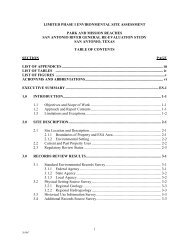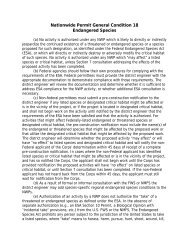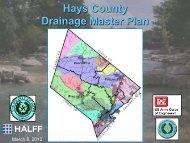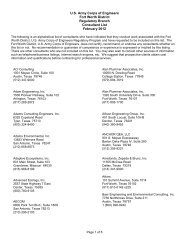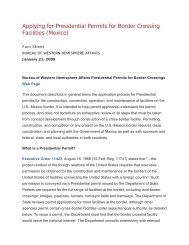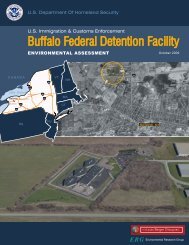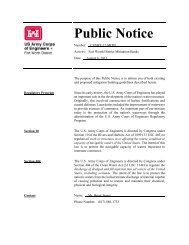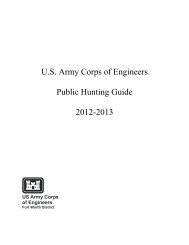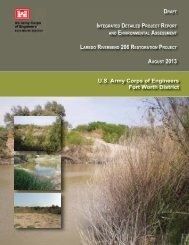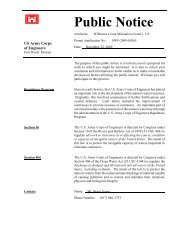environmental assessment us border patrol, tucson sector
environmental assessment us border patrol, tucson sector
environmental assessment us border patrol, tucson sector
Create successful ePaper yourself
Turn your PDF publications into a flip-book with our unique Google optimized e-Paper software.
Douglas FOB EA DraftAug<strong>us</strong>t 2011Common NameTable 3-1. Federally Listed Species for Cochise County, ArizonaScientific NameFederalStat<strong>us</strong>*Potential to Occur Within or Immediately Adjacent to AlternativeSitesPlantsCanelo Hills ladies' tresses Spiranthes delitescens E None; inhabits finely grained, highly organic, saturated soils of cienegas.Cochise pinc<strong>us</strong>hion cact<strong>us</strong> Coryphantha robbinsorum TLow; rolling hills of gray limestone, 4,200 feet to 5,200 feet elevation insemidesert grassland habitat with small shrubs, agave, and other cacti, andgrama grass is present within and adjacent to project area.Huachuca water umbelNone; inhabits cienegas, perennial low gradient streams, wetlands, andLilaeopsis schaffnerianaE, CH other healthy riverine systems at elevations between 4,000 and 6,500 feetssp. recurvaamsl and is <strong>us</strong>ually found in water with a depth of two to six inches.Lemmon fleabane Erigeron lemmonii CNone; inhabits crevices, ledges, and boulders in canyon bottoms in pineoakwoodlands.InvertebratesSan Bernardino springsnailAmphibians and ReptilesChiricahua leopard frogNew Mexico ridge-nosedrattlesnakeSonoran tiger salamanderArizona treefrog(Huachuca/Canelo DPS)Desert tortoise, SonoranpopulationNorthern Mexican gartersnakePyrgulopsis bernardinaLithobates [Rana]chiricahuensisProposed E,Proposed CHT, CHNone; only known occurrence is in the isolated Snail Spring on SlaughterRanch, over 5.0 miles from the project area.None; inhabits streams, rivers, ponds, and stock tanks that are mostly freefrom introduced fish, crayfish (Cambaridae spp.), and bullfrogs (Ranaspp.).Crotal<strong>us</strong> willardi obscur<strong>us</strong> T None; inhabits canyon bottoms in pine-oak communities.Ambystoma mavortiumstebbinsiHyla wrightorumGopher<strong>us</strong> agassiziiThamnophis equesmegalopsECCCNone; inhabits stock tanks and impounded cienegas, rodent borrows, rottedlogs, and other moist cover sites.None; inhabits Madrean oak woodlands, savannah, pine-oak woodlands,and mixed conifer forests.None; inhabits rocky, often steep hillsides and bajadas of Mojave andSonoran desertscrub and may encroach into desert grassland, juniperwoodland, interior chaparral habits, and pine communities. Washes andvalley bottoms may be <strong>us</strong>ed in dispersal.None; inhabits canyon bottoms in pine-oak communities.BirdsMexican spotted owl Strix occidentalis lucida T, CH None; nests in canyons and dense forests with multi-layered foliage.Mountain plover Charadri<strong>us</strong> montan<strong>us</strong> Proposed TNone; inhabits semi-desert grasslands and agricultural lands with sparsevegetation interspersed with bare ground and flat topography.Northern aplomado falconFalco femoralisseptentrionalisE, EXP NE None; inhabits grassland and savannah.3-19



